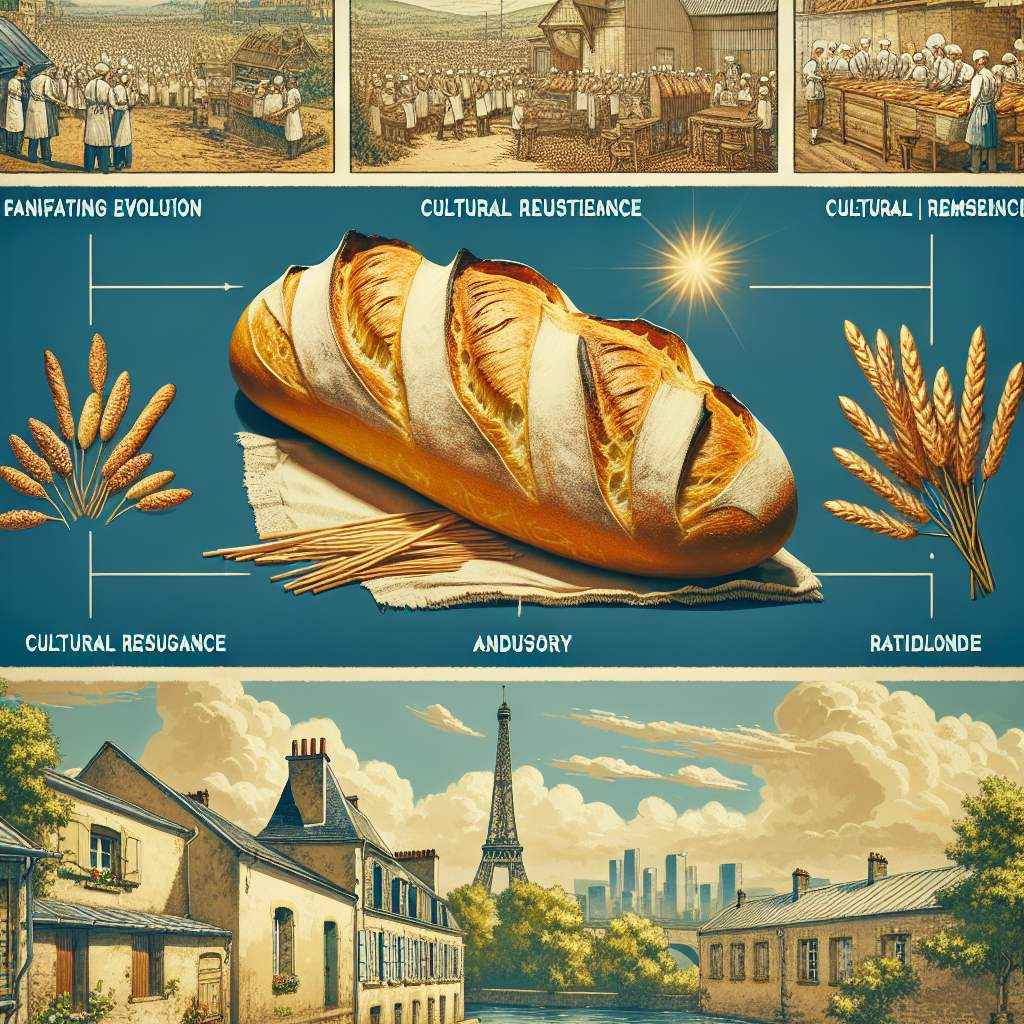Have you ever wondered about the fascinating tale behind the iconic French baguette? This charming and delectable bread has a rich history dating back to the early 19th century, and it has become an integral part of French culture and cuisine. With its thin, crispy crust and fluffy interior, the baguette has become a beloved staple not only in France but around the world. Join us on a journey as we unfold the captivating story of the French baguette, from its humble beginnings to its rise as an international culinary symbol.
History of the French Baguette
The French Baguette, a beloved staple of French cuisine, has a rich and fascinating history that dates back to the early 19th century. Its origins, evolution, and cultural significance all contribute to its enduring legacy as an iconic symbol of France.
Origin of the Baguette
The exact origin of the baguette is a subject of some debate among historians, but it is widely believed to have emerged in the early 1800s. At this time, advancements in baking technology, specifically the invention of steam ovens, allowed bakers to create longer, thinner loaves with a crisp and golden crust. This innovation gave birth to what we now know as the baguette.
Evolution of the Baguette
Initially, the baguette was not the long, slender loaf we associate with it today. It began as a shorter, thicker bread, more closely resembling the traditional French round loaf. Over time, however, bakers began to experiment with different shapes and sizes, eventually settling on the elongated form that we now recognize as the classic baguette.
Traditional Baguette Recipe
The traditional baguette recipe is a testament to the simplicity and skill required to craft this iconic bread. It typically consists of just four ingredients: flour, water, salt, and yeast. The dough is mixed, kneaded, and left to rise before being shaped and baked at a high temperature. The result is a baguette with a crusty exterior, a soft and chewy interior, and a distinct flavor that is beloved by bread enthusiasts around the world.
Symbolism and Cultural Importance
Beyond its culinary appeal, the baguette holds significant symbolism and cultural importance in French society. It has come to represent national pride, French culture, and has even inspired artistic and literary endeavors.
The Baguette as a National Symbol
The baguette has become synonymous with French identity and is often depicted in various forms of media as a quintessential symbol of the country. Its sleek, slender shape evokes elegance and sophistication, and its association with French cuisine further enhances its status as a national symbol.
The Baguette in French Culture
The baguette plays a central role in French culture and daily life. It is a common sight in bakeries across the country, with locals often making a daily trip to purchase a fresh baguette. Sharing a baguette with friends or family is a cherished ritual, and its presence at meals and gatherings is essential in maintaining French culinary traditions.
The Baguette in Literature and Art
The baguette has also found its way into the realm of literature and art. In literature, it has been mentioned in numerous works, highlighting its cultural significance and embedding it further into the fabric of French society. Likewise, painters and photographers have captured the beauty and allure of the baguette, showcasing its artistic appeal and its ability to evoke emotions and memories.

Bakeries and Baguette Making
Boulangeries, or bakeries, hold a special place in French society and are at the heart of baguette making. These establishments serve as hubs of community activity and are responsible for producing the fresh, delicious baguettes that people have come to love.
The Role of Boulangeries in France
Boulangeries are more than just places where bread is baked; they are cherished institutions that have been deeply ingrained in French culture for centuries. These establishments often embody traditional values and craftsmanship, with bakers passing down their expertise from generation to generation. The community gathers at boulangeries to not only purchase bread but also exchange news and connect with one another.
Traditional Baguette Making Process
The process of making a traditional baguette is a labor-intensive task that requires skill, precision, and patience. Bakers meticulously measure and combine the ingredients, kneading the dough to develop its gluten structure. The dough is then left to ferment, allowing the yeast to work its magic and create air pockets that contribute to the baguette’s light and airy texture. Once the dough has risen, it is shaped into the characteristic elongated form and scored before being baked in a hot oven to develop its desirable crust.
Modern Techniques and Technologies
While traditional methods remain highly esteemed, modern techniques and technologies have also made their way into the world of baguette making. Some bakers use mixers and other machinery to streamline the process and increase production. However, many artisanal bakers still prefer to rely on traditional methods, believing that the time-honored techniques result in a superior baguette.
Legal Protection and Regulations
Recognizing the cultural and culinary importance of the baguette, France has implemented legal protection and regulations to preserve its authenticity and quality. These laws ensure that the baguettes produced in France adhere to specific standards, guaranteeing a consistent and exceptional product.
The Bread Decree of 1993
A significant moment in the history of baguette regulation came with the Bread Decree of 1993. This decree established certain requirements that must be met for bread to bear the name “baguette.” It specified that baguettes should be made from specific ingredients, have a certain length, weight, and crust, and be free from additives or preservatives.
Criteria for the Traditional Baguette
In addition to the Bread Decree, there are specific criteria that must be met for a baguette to be considered “traditional.” These criteria include using high-quality ingredients, employing traditional preparation methods, and baking the baguette on-site where it is sold. By adhering to these standards, bakers can label their baguettes as “traditional,” distinguishing them from mass-produced alternatives.
Controversies and Challenges
While the regulations aim to protect the authenticity of the baguette, there have been controversies and challenges surrounding their enforcement. Some argue that the criteria are too strict and limit innovation, while others believe that the regulations are necessary to protect the integrity of the baguette as a cultural icon. Finding a balance between preserving tradition and allowing for experimentation remains an ongoing debate within the baking community.

Regional Variations and Specialties
France’s diverse regions have given rise to a wide variety of baguette types and specialties. From the traditional Parisian baguette to unique regional variations, each has its own distinct characteristics and flavors.
Baguette Types Across France
While the classic baguette is ubiquitous throughout France, specific regions have developed their own variations. For example, the Parisian baguette is characterized by its thin, crispy crust and light, airy crumb. Similarly, the baguette de tradition may be found in various regions, boasting a thicker crust and a denser crumb. These regional differences contribute to the vibrant tapestry of baguette varieties across France.
Famous Regional Baguette Specialties
Certain regions have gained fame for their specialized baguette creations. In Normandy, the baguette traditionnelle, known as the “pain de tradition normand,” is made with butter, resulting in a rich and flavorful bread. The Breton baguette, or “baguette tradition de Bretagne,” incorporates buckwheat flour, lending a unique nuttiness to the bread. These regional specialties exemplify the creativity and ingenuity of French bakers.
Influence of Local Ingredients and Traditions
The diverse agricultural landscapes of France contribute to the unique qualities found in each regional baguette. Local ingredients such as salt, grains, and even water quality can dramatically affect the flavor and texture of the bread. Additionally, each region may have its own longstanding culinary traditions that shape the techniques and flavors employed in baguette making.
The Baguette’s Influence Worldwide
As with many culinary delights, the baguette has transcended borders and gained popularity around the world. Its versatility and widespread appeal have led to adaptations and inclusion in international cuisines.
Global Popularity of the Baguette
Thanks to its delightful combination of flavors, textures, and versatility, the baguette has garnered a global following. Whether enjoyed fresh from the bakery, used as a base for sandwiches, or served as an accompaniment to a meal, the baguette’s popularity knows no bounds.
Baguette Adaptations in Different Countries
In various countries, bakers and chefs have put their unique twist on the classic baguette. In Italy, a country renowned for its bread, the filone, an Italian interpretation of the baguette, has gained popularity. It is often topped with regional ingredients such as tomatoes and olive oil. In the United States, versions like the “French loaf” or “sub roll” have become staples in sandwich shops and culinary scenes, showcasing the baguette’s adaptability and versatility.
Baguettes in International Cuisines
The baguette’s versatility makes it an excellent addition to a range of international cuisines. In Vietnamese cuisine, the banh mi sandwich exemplifies the fusion of French and Vietnamese culinary traditions, with the baguette serving as the vessel for a delightful combination of fillings. The baguette’s ability to complement a wide variety of flavors and textures has also made it a beloved accompaniment in Mediterranean and Middle Eastern cuisines.

The Baguette in Everyday Life
The baguette is not just a special treat or a culinary icon; it is an integral part of everyday life in France. Its presence can be found in various aspects of daily routines, from breakfast and snacks to picnics and traditional French cuisine.
Breakfast and Snacks
It is not uncommon for the French to start their day with a simple breakfast of a fresh baguette, butter, and jam. The combination of a crusty baguette, creamy butter, and sweet preserves is a beloved morning ritual that provides sustenance and a moment of tranquility before the day begins. Additionally, baguettes are a popular choice for snacking throughout the day, thanks to their portability and delicious taste.
Baguettes in Picnics and Picardie
The baguette’s portability and ability to stay fresh for an extended period make it a popular choice for picnics, especially in the idyllic French region of Picardie. Locals often enjoy leisurely picnics in the countryside, complete with baguettes, cheeses, and other local delicacies. The baguette’s role in these picnics not only provides sustenance but also enhances the overall experience by adding a touch of tradition and authenticity.
The Baguette in French Cuisine
The baguette is a versatile ingredient in traditional French cuisine. Whether used as the base for a croque monsieur, an essential component of a rustic tartine, or simply served alongside a hearty bowl of soup, the baguette’s crusty exterior and soft interior add depth and texture to countless dishes. Its presence in traditional French recipes highlights the enduring importance of the baguette in the culinary heritage of France.
Contests and Celebrations
The baguette’s cultural significance is celebrated through various contests and festivals held across France. These events showcase the artistry and skill of bakers, provide a platform for friendly competition, and reinforce the enduring appreciation for this culinary icon.
The Grand Prix de la Baguette
One of the most prestigious and well-known baguette competitions is the “Grand Prix de la Baguette” held annually in Paris. Bakers from all over the city come together to compete for the title of the best baguette. A panel of judges evaluates each entry based on criteria such as taste, texture, and appearance. Winning this esteemed competition is considered a great honor and can significantly boost a bakery’s reputation.
Baguette Festivals and Competitions
Beyond the Grand Prix de la Baguette, numerous baguette festivals and competitions are held throughout France. These events attract locals and tourists alike, allowing them to witness the artistry and craftsmanship of bakers firsthand. From baguette-themed parades to high-stakes baguette tournaments, these festivities highlight the cultural significance and pride associated with the baguette.
Baguette Diplomacy
The baguette’s influence goes beyond culinary celebrations within France. It has even found its way into international diplomacy. Known as “baguette diplomacy,” the exchange of baguettes between political leaders has become a symbol of friendship and goodwill. The baguette’s role in diplomacy underscores its status as a cultural ambassador for France and showcases the universal appeal and recognition it enjoys worldwide.
The Future of the Baguette
As the world continues to evolve, the baguette faces both challenges and opportunities. Balancing tradition with innovation and sustainability will be key in preserving the baguette’s legacy for future generations to enjoy.
Challenges and Opportunities
The baguette faces challenges on multiple fronts. Changes in consumer preferences and dietary trends have led to increased demand for alternative bread options, challenging the baguette’s longstanding dominance. Additionally, the artisanal techniques and time-intensive preparation methods required for traditional baguette making present challenges for bakers seeking to increase efficiency and production. However, these challenges also present opportunities for innovation and adaptation to ensure the baguette’s continued relevance and success.
Innovation and Sustainability
In response to changing consumer demands and the need for sustainability, bakers are exploring innovative techniques and ingredients to create new and exciting baguette variations. Incorporating local and organic ingredients, implementing sustainable practices in production, and embracing new technologies are some of the approaches being taken to ensure the baguette’s future while respecting tradition.
Preserving the Baguette’s Legacy
Preserving the baguette’s legacy requires a collective effort from bakers, consumers, and policymakers. It is crucial to continue supporting traditional bakers who adhere to the time-honored methods of baguette making. Likewise, consumers can contribute by valuing and seeking out authentic baguettes made with high-quality ingredients. Policymakers can play a role by providing support and incentives for bakers committed to maintaining the integrity of the baguette.
Conclusion
The story of the French baguette is one of history, culture, and craftsmanship. From its humble origins to its role as a cultural icon, the baguette has woven itself into the fabric of French society. Its enduring legacy is a testament to its universal appeal and its ability to bring people together. As the baguette continues to evolve and adapt to the changing times, its place in culinary history and the hearts of people worldwide remains unyielding. Let us celebrate and appreciate this beloved culinary icon for generations to come.
